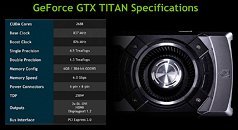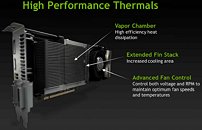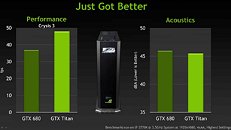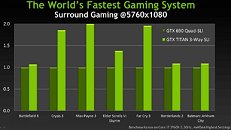Tuesday, February 19th 2013

NVIDIA GeForce GTX Titan Final Specifications, Internal Benchmarks Revealed
Specifications of NVIDIA's upcoming high-end graphics card, the GeForce GTX Titan, which were reported in the press over the last couple of weeks, are bang on target, according to a specs sheet leaked by 3DCenter.org, which is allegedly part of the card's press-deck. According to the specs sheet, the GTX Titan indeed features 2,688 out of the 2,880 CUDA cores present on the GK110 silicon, 6 GB of GDDR5 memory across a 384-bit wide memory interface, and draws power from a combination of 6-pin and 8-pin PCIe power connectors.
The GeForce GTX Titan core is clocked at 837 MHz, with a GPU Boost frequency of 876 MHz, and 6.00 GHz memory, churning out 288 GB/s of memory bandwidth. The chip features a single-precision floating-point performance figure of 4.5 TFLOP/s, and 1.3 TFLOP/s double-precision. Despite its hefty specs that include a 7.1 billion-transistor ASIC and 24 GDDR5 memory chips, NVIDIA rates the card's TDP at just 250W.More slides and benchmark figures follow.
The next slide leaked by the source reveals key features of the reference design cooling solution, which uses a large lateral blower that features RPM and voltage-based speed control on the software side, a vapor-chamber plate that draws heat from the GPU, memory, and VRM; and an extended aluminum fin stack that increases surface area of dissipation.Next up, we have performance numbers by NVIDIA. In the first slide, we see the GTX Titan pitted against the GTX 680, in Crysis 3. The GTX Titan is shown to deliver about 29 percent higher frame-rates, while being a tiny bit quieter than the GTX 680.
In the second slide, we see three GeForce GTX Titans (3-way SLI) pitted against a pair of GeForce GTX 690 dual-GPU cards (quad-SLI). In every test, the Titan trio is shown to be faster than GTX 690 Quad-SLI. In Crysis 3, GTX Titan 3-way SLI is shown to be about 75 percent faster; 100 percent faster in Max Payne 3, 40 percent faster in TESV: Skyrim, and 95 percent faster in Far Cry 3. Why this comparison matters for NVIDIA is that if Titan does end up being a $1000 product, NVIDIA will have to sell three of them while offering something significantly better than GTX 690 quad-SLI.
Source:
3DCenter.org
The GeForce GTX Titan core is clocked at 837 MHz, with a GPU Boost frequency of 876 MHz, and 6.00 GHz memory, churning out 288 GB/s of memory bandwidth. The chip features a single-precision floating-point performance figure of 4.5 TFLOP/s, and 1.3 TFLOP/s double-precision. Despite its hefty specs that include a 7.1 billion-transistor ASIC and 24 GDDR5 memory chips, NVIDIA rates the card's TDP at just 250W.More slides and benchmark figures follow.
The next slide leaked by the source reveals key features of the reference design cooling solution, which uses a large lateral blower that features RPM and voltage-based speed control on the software side, a vapor-chamber plate that draws heat from the GPU, memory, and VRM; and an extended aluminum fin stack that increases surface area of dissipation.Next up, we have performance numbers by NVIDIA. In the first slide, we see the GTX Titan pitted against the GTX 680, in Crysis 3. The GTX Titan is shown to deliver about 29 percent higher frame-rates, while being a tiny bit quieter than the GTX 680.
In the second slide, we see three GeForce GTX Titans (3-way SLI) pitted against a pair of GeForce GTX 690 dual-GPU cards (quad-SLI). In every test, the Titan trio is shown to be faster than GTX 690 Quad-SLI. In Crysis 3, GTX Titan 3-way SLI is shown to be about 75 percent faster; 100 percent faster in Max Payne 3, 40 percent faster in TESV: Skyrim, and 95 percent faster in Far Cry 3. Why this comparison matters for NVIDIA is that if Titan does end up being a $1000 product, NVIDIA will have to sell three of them while offering something significantly better than GTX 690 quad-SLI.




132 Comments on NVIDIA GeForce GTX Titan Final Specifications, Internal Benchmarks Revealed
If you want Titan to run Double Percision. It will lock that card at base clock. Its a smart move since this is aimed at gamers but you'd think its been crippled enough at $1k with no ECC and support they'd leave it alone.
Just thought that was interesting.
Taxes pay for Schools, Teachers, Law Enforcement, Hospitals (in some EU), Welfare (think disability) and much more. It also pays for the biggest expense of most countries - the Military (inclusive of R&D and actually funding an Army/Navy?air Force). And Nuclear Weapons.
USA is resource rich (Like Russia and China and other BRIC countries). It can afford lower taxes as it sells or produces a lot of it's own consumable product.
The UK is tiny in comparison, has no wealth of natural resource and relies on taxes to fund all of the above.
Simple.
Titan is still too expensive.
Nvidia also seem to have the noise/cooling solution down to a fine art.
The price tag though, that's tough. I need at least two...but there is no way for me to afford such things.
I already have dual 7950's, and they aren't fast enough, and a single Titan isn't going beat dual 7950's. Two Titans...maybe. Maybe three.:roll: I want that smecksky SLI bridge, too.
I WANT DIS NAOW!!
sadly, I have kids to feed instead. :banghead:
The first thing i noticed was that SLI bridge. :twitch:
:rockout:
I mean really, if you can...that might be a deal closer for me. Sell me three cards with a bridge in a nice package deal. I already got the Dominator Platinums...too bad the pic looks like you'd never be able to install any case plugs, like power, reset, you know...the important stuff.:roll:
:respect::respect::respect:
But it better damn well light up the NV logo...dammit.:banghead:
I wouldnt even want to stick Titan on water cooling either. The stock cooling is way to sexy to take off.